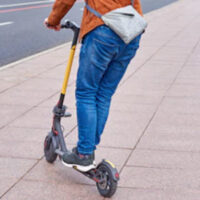Electric Scooters: Fun and Convenient, but Deceptively Dangerous

Transportation development
According to the United States Consumer Product Safety Commission, there were seventy-seven thousand and two hundred (77,200) injuries from 2017 to 2021 that involved micromobility devices, with e-scooters making up the highest percentage of increase in injuries. Micromobility devices include e-scooters, e-bikes, and hoverboards. E-scooters are commonly operated throughout Baltimore City since the Department of Transportation initiated a temporary “pilot program” for e-scooters in August of 2018. Although the seemingly instantaneous development of electric scooters promotes a cheap, safe, and convenient ride; they are deceptively dangerous.
Transportation has developed throughout the years to enhance mobility and promote easier and more efficient travel. These developments have come to fruition in various forms and have shaped the way a large part of modern transportation occurs. Citizens throughout the years have turned to bicycles, scooters, hoverboards, and other alternatives to driving vehicles. People have sought alternatives to driving cars and trucks around cities that are too cluttered with traffic on the roadways, the cost of maintaining a car/truck is too high, or to fulfill the need to only travel short distances.
Legal classification/regulations
In Maryland, electric low speed scooters (e-scooters), are considered the same as bicycles for the purposes of regulation. Although e-Scooter users must follow the same rules/laws as bicyclists, they operate by electric power rather than mechanical. Consumers can rent and operate an e-scooter with the click of a button on their smartphone by utilizing applications provided by popular companies such as Lime, Spin, and LINK.
Maryland law defines an electric low speed scooter as a vehicle that:
- Is designed to transport only the operator;
- Weighs less than one hundred (100) pounds;
- Has single wheels in tandem or a combination of one or two wheels at the front and rear of the vehicle;
- Is equipped with handlebars and a platform designed to be stood on while riding;
- Is solely powered by an electric motor and human power; and
- Is capable of operating at a speed of up to twenty (20) miles per hour.
Individuals that operate an e-scooter do not need a driver’s license, nor are they legally required to wear a helmet unless they are under the age of 16 years old. Although legislation permits e-scooter riders to travel on the same roadways as those who ride bikes, many riders are confused or not fully educated on where they are and permitted to operate.
Discuss potential Legal Remedies with a Maryland Personal Injury Lawyer.
If you were injured while operating an e-scooter, or suffered injury as a result of another individual’s actions while operating an e-scooter, you may be entitled to compensation for your losses. For more information on what to do if you have been involved in an e-scooter accident, or to set up a fee case evaluation, please call our office at 410-844-6000 or go online to reach Furman | Honick Law to speak to one of our attorneys located in Owings Mills, Maryland.
References:
mgaleg.maryland.gov/mgawebsite/laws/StatuteText?article=gtr§ion=11-117.2&enactments=false
cpsc.gov/Newsroom/News-Releases/2023/E-Scooter-E-Bike-and-Hoverboard-Injuries-and-Deaths-Are-on-the-Rise-Celebrate-National-Fire-Prevention-Week-with-the-Safe-Use-of-Micromobility-Products
mgaleg.maryland.gov/2019RS/Chapters_noln/CH_227_hb0748e.pdf